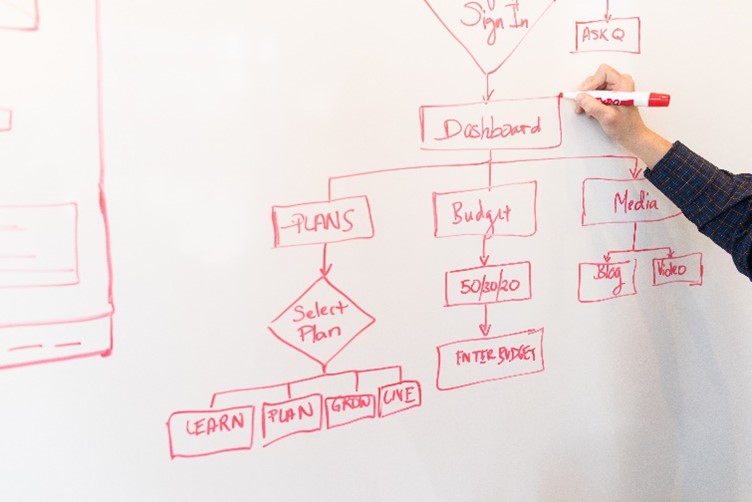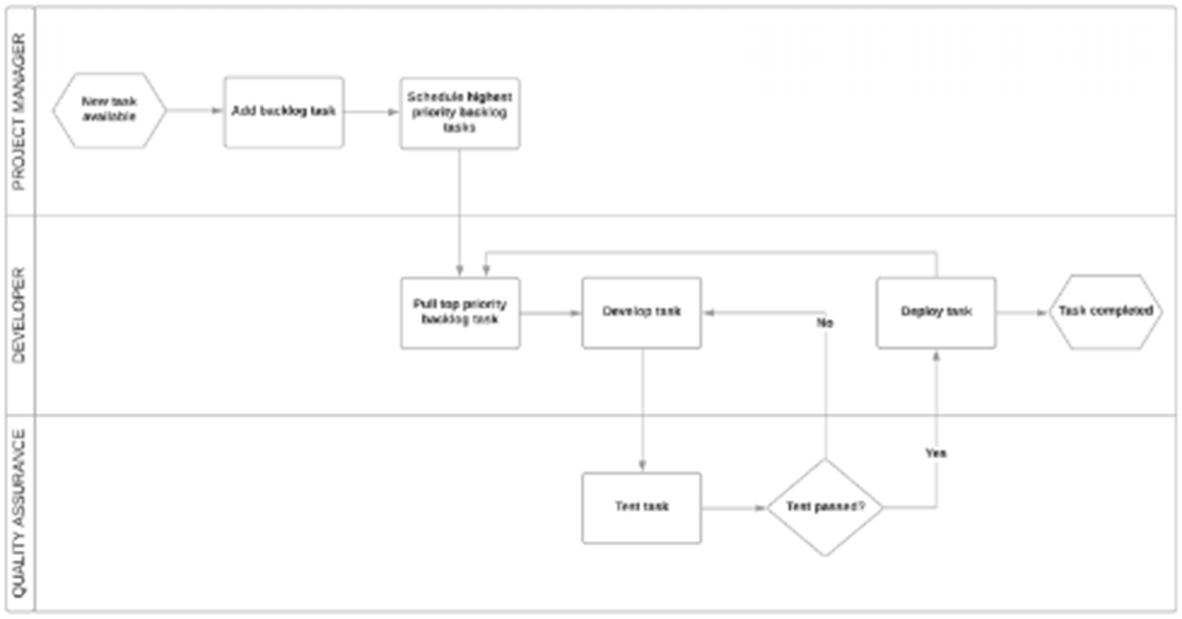A picture is worth a thousand words. The flowchart, a project management tool, exemplifies that saying with the power to quickly convey complex information using a diagram. A flowchart can not only convey interconnecting steps but be used in monitoring progress and periodic status reporting. When preparing for the Project Management Professional® (PMP) exam, project managers should know the Seven Management and Planning Tools, including the flowchart, by definition and application within the context of project work.
On this page:

Free Download:
The Ultimate Data Quality Guide
Learn about the 7 data quality
tools every project manager
should know!
What is a flowchart
A flowchart, or process map, is a graphic display of sequential steps needed to complete a goal. They can also be designed to show “branching possibilities that depict one or more inputs and transforms them to outputs.”

Value of a flowchart
You have likely created flowcharts in meetings without specifically thinking, “Wow, I need to create a graphic representation showing the interconnectedness of steps in a sequential process.”

Image Source https://assets.entrepreneur.com/content/3×2/2000/20200420050019-Ent-Flow.jpeg
Whether you are drawing on a whiteboard in a conference room or a drawing board in a virtual meeting, the process of mapping steps to identify what comes when in a sequence is flowcharting. It is a powerful tool for any industry, not just project management, as it helps the team better understand the problem in terms of steps, inputs, dependencies, and branches. When flowcharting, certified project managers are using the tool to streamline communications among team members, stakeholders, and teams through better analysis. Consider these flowchart benefits highlighted by the Project Management.com resource:

PMP credential holders know the process of creating a flowchart is as important as the deliverable of the flowchart itself. The quality tool forces the project manager (and team) to critically look at a process and capture how it works (or what is not working).
Uses of flowcharts for project management
A classic example of a flowchart in project management is the workflow diagram. Workflow is the series of steps in a process, and the diagram of that is a flowchart; a workflow diagram is the flowchart of the workflow. Consider this description of workflow diagrams for Project Management:
You can swap out “workflow” with “flowchart” and the meaning still applies. In a flowchart, the points mapped can include tasks, inputs, decision points, process steps, and outputs. From a project management lens, the flowchart can illuminate what is needed to complete a task so the process is as efficient as possible with no redundancies. In the workflow diagram below, which is similar to examples you may see included on the PMP exam, you see different items are mapped with different shapes:
 Image Source Lucidchart.com Workflow-diagram
Image Source Lucidchart.com Workflow-diagram
Project Managers using flowcharts should know the shapes in the diagram convey their meaning. In this flowchart shape key from Project Management.com the symbol and meaning of it are listed for reference:
 Image source: Using Flowcharts in Project Management
Image source: Using Flowcharts in Project Management
Project Management and planning software, such as Microsoft Project or Visio, provide shape choices to enhance the flowchart design process. Simple, consistent shapes are an important part of the flowchart being easy to understand at a glance; this increases the tool’s communication value.
Flowcharts can be used throughout the project but are frequently used most in planning work. A concept embedded in PMP exam questions may be that the value of the flowchart tool is to move work through the process of determining, delegating, and scheduling each task to the team members. In project management, it is important to know more than the tools available, but also when to use them.
Studying for the PMP Exam?
Types of flowcharts
For PMP exam questions about a flowchart, test takers should know there is more than one type. In the Project Management Institute® (PMI) library article, Flowcharting Project Management Critical Decisions, this example is shared:
 Image source: Flowcharting Project Management Critical Decisions
Image source: Flowcharting Project Management Critical Decisions
Note the use of different shapes, clear labels on each shape, and the connecting lines. Without knowing the specifics of the project, information can be gleaned about the process from the flow chart. Although with a different layout, this example is also a flowchart and is known as a swimlane flowchart:

Figure 1 Image Source: Project Management.com
Consistent shapes with connecting lines and clear labels are used again. However, in this flowchart, which could be created by the PMP credential holder in the planning stages to map out team tasks in a process, there are three distinct lanes (horizontal paths). It is another layer of process information conveyed graphically. To prep for flowchart questions on the PMP exam, project managers should have familiarity with these types:

Flowcharts in context of PMP Exam
In preparation for the PMP exam, and as part of practicing project management standards, the flowchart should be understood as one of the quality tools. A flowchart tool can be used in one of many formats including process flowcharts, workflow diagrams, swim lanes, and data flowcharts.
Flowchart-focused questions on the PMP exam will assume test takers’ knowledge of the 47 processes, 10 knowledge areas, and 5 process groups in the context of Communication Management, Quality Management, and Integration Management. Study plans for the future PMP credential holder should include a careful review of the PMP exam reference list provided by the PMI. Questions may be structured as inquiries into the uses of a flowchart or include requests to interpret data in a flowchart.
Why flowchart
Project Management, as a profession, requires much from its practitioners. Project Managers, who already hold the PMP credential or are preparing to earn it, should leverage the flowchart tool to increase the success rates of their projects. Whether as a workflow or swim lane diagram, as a process flowchart, or a data flowchart, the act of diagraming the connection and influence of factors within a process ensures better planning and more positive outcomes.
Upcoming PMP Certification Training – Live & Online Classes
| Name | Date | Place | |
| PMP Certification Training | Feb 2,3,4,5 8:30am-6:00pm | Your Selected City | View Details |
| PMP Certification Training | Feb 2,3,4,5 8:30am-6:00pm | Your Selected City | View Details |
| PMP Certification Training | Feb 2,3,4,5 8:30am-6:00pm | Your Selected City | View Details |
| PMP Certification Training | Mar 2,3,4,5 8:30am-6:00pm | Your Selected City | View Details |
| PMP Certification Training | Mar 2,3,4,5 8:30am-6:00pm | Your Selected City | View Details |
| PMP Certification Training | Mar 2,3,4,5 8:30am-6:00pm | Your Selected City | View Details |
| PMP Certification Training | Mar 30,31, Apr 1,2 8:30am-6:00pm | Your Selected City | View Details |
| PMP Certification Training | Mar 30,31, Apr 1,2 8:30am-6:00pm | Your Selected City | View Details |
| PMP Certification Training | Mar 30,31, Apr 1,2 8:30am-6:00pm | Your Selected City | View Details |
| PMP Certification Training | Apr 27,28,29,30 8:30am-6:00pm | Your Selected City | View Details |
| PMP Certification Training | Apr 27,28,29,30 8:30am-6:00pm | Your Selected City | View Details |
| PMP Certification Training | Apr 27,28,29,30 8:30am-6:00pm | Your Selected City | View Details |
| PMP Certification Training | Jun 1,2,3,4 8:30am-6:00pm | Your Selected City | View Details |
| PMP Certification Training | Jun 1,2,3,4 8:30am-6:00pm | Your Selected City | View Details |
| PMP Certification Training | Jun 1,2,3,4 8:30am-6:00pm | Your Selected City | View Details |
| PMP Certification Training | Jul 6,7,8,9 8:30am-6:00pm | Your Selected City | View Details |
| PMP Certification Training | Jul 6,7,8,9 8:30am-6:00pm | Your Selected City | View Details |
| PMP Certification Training | Jul 6,7,8,9 8:30am-6:00pm | Your Selected City | View Details |
| PMP Certification Training | Aug 3,4,5,6 8:30am-6:00pm | Your Selected City | View Details |
| PMP Certification Training | Aug 3,4,5,6 8:30am-6:00pm | Your Selected City | View Details |
| PMP Certification Training | Aug 3,4,5,6 8:30am-6:00pm | Your Selected City | View Details |
| PMP Certification Training | Sep 8,9,10,11 8:30am-6:00pm | Your Selected City | View Details |
| PMP Certification Training | Sep 8,9,10,11 8:30am-6:00pm | Your Selected City | View Details |
| PMP Certification Training | Sep 8,9,10,11 8:30am-6:00pm | Your Selected City | View Details |


 New Horizons
New Horizons
 Project Management Academy
Project Management Academy
 Six Sigma Online
Six Sigma Online
 TCM Security
TCM Security
 TRACOM
TRACOM
 Velopi
Velopi
 Watermark Learning
Watermark Learning
 Login
Login




 New Horizons
New Horizons
 Project Management Academy
Project Management Academy
 Velopi
Velopi
 Six Sigma Online
Six Sigma Online
 TCM Security
TCM Security
 TRACOM
TRACOM
 Watermark Learning
Watermark Learning